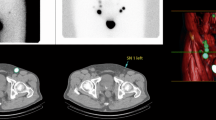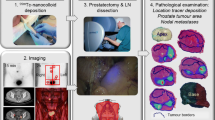Abstract
Purpose
To evaluate benefits of sentinel lymph node (SLN) biopsy for staging accuracy in prostate cancer. Extended pelvic lymph node dissection (ePLND) is a preferred staging tool; however, it may underestimate the incidence of nodal involvement.
Methods
Eighty patients with estimated risk of lymphadenopathy above 5 % based on Briganti nomogram had Tc-99m-labeled nanocolloid injected into the prostate. Planar lymphoscintigraphy and single-photon emission computed tomography/CT were performed to localize SLNs. Radioguided SLN dissection was followed by backup ePLND comprising external iliac, obturator and internal iliac regions. All SLNs were serially sectioned every 150 μm and examined using hematoxylin and eosin; immunohistochemical staining was applied every 300 μm.
Results
A total of 335 SLNs were detected, and 17 % were located outside ePLND template. Nodal metastases were diagnosed in 32 patients (40 %). Without radioguided SLN localization, solitary metastases posteriorly to the branches of the internal ilaic vessels, in pararectal and common iliac regions would not have been removed in five of 32 patients (16 %). Using standard histology protocol, we would have diagnosed metastases in 23 patients with median size of 2.8 mm. Serial sectioning of SLN and immunohistochemistry led to the detection of metastases in additional nine patients (28 %) with median size of 0.2 mm.
Conclusion
ePLND comprised 83 % of SLNs, at least one SLN laid outside its template in 28 % of patients. ePLND and SLN dissection combined with nodal serial sectioning and immunohistochemistry increased the detection rate of nodal metastases by 68 % in comparison with ePLND alone and standard histology protocol.


Similar content being viewed by others
Abbreviations
- CT:
-
Computed tomography
- ePLND:
-
Extended pelvic lymph node dissection
- ICG:
-
Indocyanine green
- IQR:
-
Interquartile range
- ITC:
-
Isolated tumor cells
- H&E:
-
Hematoxylin and eosin
- PSA:
-
Prostate-specific antigen
- SLN:
-
Sentinel lymph node
- SPECT:
-
Single-photon emission computed tomography
References
Cheng L, Zincke H, Blute ML et al (2001) Risk of prostate carcinoma death in patients with lymph node metastasis. Cancer 91:66–73
Heidenreich A, Bellmunt J, Bolla M et al (2011) European Association of Urology. EAU guidelines on prostate cancer. Part 1: screening, diagnosis, and treatment of clinically localized disease. Eur Urol 59:61–71
Briganti A, Blute ML, Eastham JH et al (2009) Pelvic lymph node dissection in prostate cancer. Eur Urol 55:1251–1265
Abdollah F, Sun M, Thuret R et al (2010) Decreasing rate and extent of lymph node staging in patients undergoing radical prostatectomy may undermine the rate of diagnosis of lymph node metastases in prostate cancer. Eur Urol 58:882–892
Wawroschek F, Wagner T, Hamm M et al (2003) The influence of serial sections, immunohistochemistry and extension of pelvic lymph node dissection on the lymph node status in clinically localized prostate cancer. Eur Urol 43:132–137
Briganti A, Karakiewicz PI, Chun FK et al (2007) Percentage of positive biopsy cores can improve the ability to predict lymph node invasion in patients undergoing radical prostatectomy and extended pelvic lymph node dissection. Eur Urol 51:1573–1581
Holl G, Dorn R, Wengenmair H et al (2009) Validation of sentinel lymph node dissection in prostate cancer: experience in more than 2,000 patients. Eur J Nucl Med Mol Imaging 36:1377–1382
Jeschke S, Beri A, Grüll M et al (2008) Laparoscopic radioisotope-guided sentinel lymph node dissection in staging of prostate cancer. Eur Urol 58:126–133
Joniau S, Van den Bergh L, Lerut E et al (2013) Mapping of pelvic lymph node metastases in prostate cancer. Eur Urol 63:450–458
Rousseau C, Rousseau T, Bridji B et al (2012) Laparoscopic sentinel lymph node (SLN) versus extensive pelvic dissection for clinically localized prostate carcinoma. Eur J Nucl Med Mol Imaging 39:291–299
Schumacher MC, Burkhard FC, Thalmann GN et al (2008) Good outcome for patients with few lymph node metastases after radical retropubic prostatectomy. Eur Urol 54:344–352
Mattei A, Fuechsel FG, Bhatta Dhar N et al (2008) The template of the primary lymphatic landing sites of the prostate should be revisited: results of a multimodality mapping study. Eur Urol 53:118–125
Van der Poel HG, Buckle T, Brouwer OR et al (2011) Intraoperative laparoscopic fluorescence guidance to the sentinel lymph node in prostate cancer patients: clinical proof of concept of an integrated functional imaging approach using a multimodal tracer. Eur Urol 60:826–833
Jeschke S, Lusuardi L, Myatt A et al (2012) Visualisation of the lymph node pathway in real time by laparoscopic radioisotope and fluorescence-guided sentinel lymph node dissection in prostate cancer staging. Urology 80:1080–1087
Heidenreich A, Varga Z, Von Knobloch R (2002) Extended pelvic lymphadenectomy in patients undergoing radical prostatectomy: high incidence of lymph node metastasis. J Urol 167:1681–1686
Golimbu M, Morales P, Al-Askari S et al (1979) Extended pelvic lymphadenectomy for prostatic cancer. J Urol 121:617–620
Fukuda M, Egawa M, Imao T et al (2007) Detection of sentinel node micrometastasis by step section and immunohistochemistry in patients with prostate cancer. J Urol 177:1313–1317
Briganti A, Larcher A, Abdollah F et al (2012) Updated nomogram predicting lymph node invasion in patients with prostate cancer undergoing extended pelvic lymph node dissection: the essential importance of percentage of positive cores. Eur Urol 61:480–487
De Boer M, van Deurzen CH, van Dijck JA et al (2009) Micrometastases or isolated tumor cells and the outcome of breast cancer. N Engl J Med 361:653–663
Pagliarulo V, Hawes D, Brands FH et al (2006) Detection of occult lymph node metastases in locally advanced node-negative prostate cancer. J Clin Oncol 24:2735–2742
Acknowledgments
This study was funded by Institutional Resources for Supporting the Research Organization provided by the Czech Ministry of Health to Masaryk Memorial Cancer Institute.
Conflict of interest
The authors declare that they have no conflict of interest.
Author information
Authors and Affiliations
Corresponding author
Rights and permissions
About this article
Cite this article
Staník, M., Čapák, I., Macík, D. et al. Sentinel lymph node dissection combined with meticulous histology increases the detection rate of nodal metastases in prostate cancer. Int Urol Nephrol 46, 1543–1549 (2014). https://doi.org/10.1007/s11255-014-0704-3
Received:
Accepted:
Published:
Issue Date:
DOI: https://doi.org/10.1007/s11255-014-0704-3




